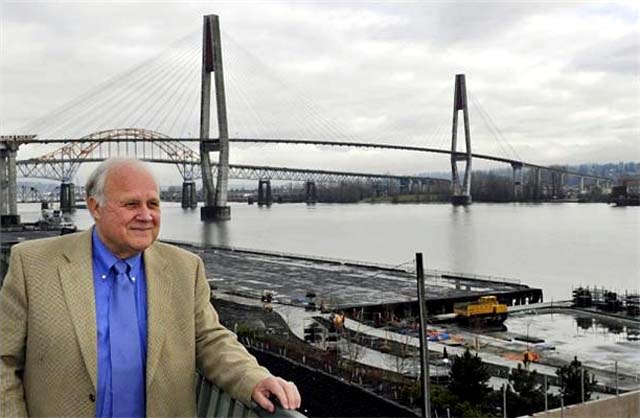|

|


New Westminster mayor Wayne Wright - Date unknown Jenelle Schneider.
2 June 2013
Railway Noise Top Complaint
to New Westminster City Hall
New Westminster British Columbia - It is a rare day when New Westminster Mayor Wayne Wright doesn't hear from an angry resident about
the horns sounded by train crews transiting his Fraser River community in the middle of the night or early morning.
In recent years, Wright has noticed a dramatic increase in trains after railway companies moved a lot of their traffic out of Vancouver's downtown port
yards.
That has brought a spike in complaints from New Westminster residents constantly woken at night by the "whistling", the use of loud air-driven horns,
of trains from four major railway companies that cross the city at six intersections.
Some nights, the mayor himself is woken several times as freight trains, one after the other, travel up and down the river corridor or noisily shunt cars in
the rail yard at the foot of Begbie Street.
In a city only 18 square kilometres in size, with dense urban towers along the waterfront, the noise caused by Burlington Northern Santa Fe, Canadian National,
Canadian Pacific, and the Southern Railway of British Columbia has risen to the top of New Westminster's complaints, Wright said.
It got so bad in recent years that residents took their complaint to the Canadian Transportation Agency, which is set to rule on an application to have the
railways quiet down between 11 p.m. and 7 a.m.
Wright and Coun. Chuck Puchmayr, the co-chairs of a new joint city-railway advisory committee, said they are worried sleep-deprived residents will take matters
into their own hands if they don't get relief.
"The railways don't need to be using prairie whistles in a city," said Wright. "There are other types of lower-impact whistles they can use. We
need a whole new urban law on whistling."
Puchmayr says he has eMails from people in nearby residential towers who are "feeling hopeless" and who have got into altercations with train crews
as they pass through the train yard below.
"Some are talking about "aggressive interactions" between the rail crews and the people living in the apartments," Puchmayr said.
"That to me is a very dangerous scenario. I don't want to see us get to that situation where the rail crews think people are throwing things at them and
the people think rail crews are intentionally blowing whistles."
But train noise is a problem not unique to New Westminster. As railways across Canada become busier, as ports expand both their physical size and the volume of
cargo they ship, and as municipalities facing growth pressures encroach into adjacent industrial areas, conflicts arise.
It is not just late-night train horns that are causing conflicts. The constant vibration from rumbling trains, the shotgun sounds of disconnecting air brakes,
the clash and crash of cars being shunted in yards, and the pollution created by diesel engines, all within close urban confines, are problems railway
municipalities have to contend with.
The problem is that in many cases the railways were there first and they have a national imperative to operate, according to Cynthia Lulham, the project
manager for a joint Federation of Canadian Municipalities and Railway Association of Canada initiative to try to bridge those conflicts.
"In the past, communities were built up around railways. Everybody went "Yippee, the railway is coming!"
"But in the last 100 years we've seen a big change and now we are seeing people living in proximity to railways complain about noise, vibration, and
pollution," said Lulham, who is an elected councillor in Westmount, Quebec.
Lulham said municipalities also haven't always been good neighbours, re-zoning nearby industrial land for residential infill development without consulting
adjacent railways. Once a developer has the right to build, it is very difficult to retroactively mitigate the rail noise effects.
"There is not a lot we can do about the existing situation, but moving forward we're seeing developments being built right up to the edge of the railways
and those future residents are our future complainants."
In the past 10 years, the joint FCM-railways group has signed several memorandums of understandings and developed actions on how to resolve some of those
conflicts.
On Friday, the joint association moved one step closer, releasing new guidelines for how municipalities can safely develop around railways, with specific
recommendations on building types and setbacks.
The joint association's guidelines offer suggestions on how cities can head off such conflicts by consulting with railways and incorporating noise-reduction
design concepts that can sometimes result in housing successfully being built right next to busy railways.
Railways in Canada are governed under federal law and Transport Canada has strict rules for how trains move. The use of horns is required by law unless a
municipality has gone through a costly and difficult process to either close a crossing or install traffic barriers and safety fences to prevent
trespass.
Most municipalities have bylaws governing after-hours noise, and set the threshold for disturbing sound levels at about 90 decibels. But the average train
whistle is between 100 and 150 decibels, according to Dr. Paul Van Buynder, the chief medical health officer for Fraser Health Authority. With only a few
exceptions, railways in Canada don't have to obey municipal noise level bylaws.
Railways in Canada and the United States universally oppose the silencing of train horns, arguing they are necessary to protect public and railway employees.
Every year there are hundreds of cases of trains hitting people and vehicles, resulting in fatalities.
But railways will grudgingly agree to "whistle cessation" laws enacted by cities, when possible.
"Train whistles are one of our bigger complaints, absolutely," said Breanne Feigel, CP's director of public affairs. "The solution is a joint
collaboration. If a community feels strongly that there should no longer be train whistling in their community, they have a set of things they need to do in
order to make it safe for their residents. The responsibility isn't on the railway solely to come up with solutions. Fundamentally you will always hear the
railways say whistles are the No. 1 way to protect the public."
Feigel wouldn't comment on the New Westminster dispute because it is the subject of legal action.
In New Westminster, residents of the Quayside neighbourhood reached a mediated settlement several years ago with the railway companies to quiet down yard
noise. When the railways appeared to ignore the agreement, the neighbourhood applied to the Canadian Transportation Agency for an order preventing train noise
between 11 p.m. and 7 a.m. After a court challenge by the railways, the CTA is set to release its ruling shortly, according to James Crosty, one of the
neighbours who filed the complaint.
He said the case is being watched carefully by 21 other municipalities in Canada who also want to ban late-night train noise.
"It is unbelievable what we have been through. When you are dealing with BNSF, CN, CP, and the railway conglomerates on a federal basis, they don't have
to listen to municipalities," he said. "For us, we've been through the wringer."
In recent years, the number of municipalities across Canada that have brought in restrictions against whistling or sounding of train horns has increased
significantly. In 2005, Langley joined the growing list, and last year Surrey banned railway companies running trains to the Roberts Bank port from sounding
their horns at a number of crossings.
The Surrey bylaw followed a 2007 study of 66 crossings along the Roberts Bank railway corridor through Delta, Surrey, Langley Township, and the City of
Langley. With rail traffic expected to increase to as many as 38 trains per day by 2021, up from about 18 now, the project sought to reduce traffic congestion,
noise pollution, and disruption to neighbouring communities.
New Westminster has already undertaken the first steps to ban whistling at several crossings, Wright said. The city commissioned an engineering study of the
crossings and now it needs to figure out how who should pay for the upgrades. The cost could range in the millions of dollars.
Last week, Van Buynder told a town-hall meeting in New Westminster that train noise can be a health concern.
He said a public health assessment should be carried out before Port Metro Vancouver approves a proposal by Fraser Surrey Docks to handle four million tonnes
of American thermal coal annually at its docks across the river from New West. The facility would be supplied by trains.
Along with the air pollution and other contamination that would accompany coal shipments, noise also represents a threat to community health, Van Buynder
said.
"It may not be so bad a noise that you're impacting your mental health," he said in an interview. "But from a community amenity point of view,
if you've got three times as many trains, and they all take 15 minutes to pass, and they're all tooting their horns and so on, then that's a negative
effect.
"So it's not that I think the noise itself is going to cause a major health impact, it's one of half a dozen different things that have to be included in
an impact assessment."
Van Buynder pointed to a Dutch study from 2000 that showed exposure to noise can harm mental health, children's school performance, and lead to increases in
blood pressure and stress.
Jeff Lee and Jessica Barrett.



Vancouver Island
British Columbia
Canada
|

